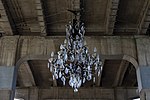Granville Island

Granville Island is a peninsula and shopping district in Vancouver, British Columbia, Canada. It is located across False Creek from Downtown Vancouver under the south end of the Granville Street Bridge. The peninsula was an industrial manufacturing area in the 20th century. The area was named after Granville Leveson-Gower, 2nd Earl Granville. Granville Island includes a public market, an marina, a hotel, the False Creek Community Centre, as well as various performing arts theatres including the Arts Club Theatre Company and Carousel Theatre. Granville Island was used as the finale of the film Mission: Impossible – Ghost Protocol (2011). The Vancouver International Children's Festival, the Vancouver Fringe Festival, and the Vancouver Writers Fest are all
Excerpt from the Wikipedia article Granville Island (License: CC BY-SA 3.0, Authors, Images).Granville Island
Old Bridge Street, Vancouver Granville Island (Fairview)
Geographical coordinates (GPS) Address Nearby Places Show on map
Geographical coordinates (GPS)
| Latitude | Longitude |
|---|---|
| N 49.270833333333 ° | E -123.13416666667 ° |
Address
Granville Island Broom Co.
Old Bridge Street 1406
V6H 3S6 Vancouver, Granville Island (Fairview)
British Columbia, Canada
Open on Google Maps










